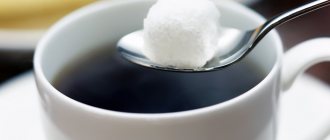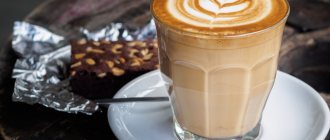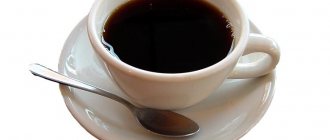It’s hard to imagine life today without aromatic coffee. Some people like strong espresso, others coffee with cream, but the issue of calories worries both of them, especially if they are on a diet. Some people are sure that coffee is a high-calorie drink, but this is not true. There are almost no calories in coffee beans, both in coffee beans and in water, so the calorie content of natural coffee without additives is minimal and equal to 2-3 kcal. Thus, the calorie content of the final drink directly depends on the energy value of the additives that are added to the coffee.
Natural coffe
Brewed coffee has the lowest calorie content. Depending on the level of grinding and roasting, the drink is brewed differently:
- small. Designed for Turkish coffee. The grains ground into flour make the drink thick. Calorie content – 2 kcal;
- average. Brew in a coffee maker. Espresso and Americano shots contain 1 kcal;
- Coarse grinding is prepared in a French press or in a cup. A dense sediment remains at the bottom and small particles do not enter the oral cavity along with the drink. The calorie content of cooked in Turk is 4 kcal.
Photo: caffevita.ru
The more grains are in the liquid, the more nutrients get into the drink. Ristretto or espresso have minimal calorie content, as they are brewed quickly in a coffee machine. 220 ml contains 1 kcal. When brewing in a filter, in the same volume, it contains an average of 4 kcal. Turk takes the longest to cook, so 200 ml contains 4 kcal.
Different types of grains have their own characteristics. The most common:
- Robusta. The drink is strong and bitter with an earthy aftertaste. Contains 3 times more caffeine than Arabica. It is characterized by low cost due to ease of cultivation;
- Arabica Refers to expensive varieties. Endowed with a wide range of tastes - from sweetish-soft to sharp and tart. It has a refined taste and aroma.
Comparison table for types of grains per 100:
| Robusta | Arabica | |
| Proteins, g | 13,9 | 7 |
| Fats, g | 14,4 | 8 |
| Carbohydrates, g | 29,5 | 0,20 |
| Calorie content, kcal | 331 | 101 |
Arabica is lower in calories compared to robusta. In 200 ml the difference is not significant, only 0.5-1 kcal.
Photo: www.paulig.ru
Differences:
| Robusta | Arabica | |
| Motherland | Congo. First mention 18th century. | Ethiopia. First mention 9th century. |
| Place of cultivation | Grows on plains. | Grown at an altitude of 1-2.8 km above sea level. The higher the tree grows, the richer and more intense the taste of the grains. |
| Appearance | Bush | Tree |
| Grains | Oval | Round |
| Taste | Simple, rough. Bitterness is pronounced. | Rich with bright acidity. |
| Caffeine | Contains 2 times more than Arabica | |
| Production | 35% | 65% |
| Manufacturer | Vietnam | Brazil |
Coffee contains various substances in the following quantities:
| % | |
| Caffeine | 1,5 |
| Tannins | 5,5 |
| Esters of caffeic acids | 6,5 |
| Lemon acid | 1 |
| Trigonelline | 1 |
| Trace elements and minerals | 5 |
| Purine bases | 1,2 |
| Oxalic acid | 0,4 |
| Polysaccharides | 75 |
By the way, girls very often use coffee to wrap their belly and other parts of the body, because it does a good job of breaking down fat.
A cup of natural coffee contains:
- iron – 2 mg;
- vitamin PP – 0.6 mg;
- phosphorus – 7 mg;
- calcium – 5 mg;
- potassium – 9 mg;
- sodium – 2 mg.
We invite you to watch a video about the rules of drinking coffee with Elena Malysheva in the “Live Healthy” program.
It is easy to prepare the ground product yourself to prepare various coffee drinks. To do this, you will need to purchase beans, fry them and grind them in a coffee grinder. A teaspoon contains 5 g of ground coffee, which is 10 kcal. A 250 ml cup of the finished drink contains 2 kcal.
Photo: mnevkusnotut.ru
Coffee drinks may contain more calories
Depending on what you put in your coffee and how much of it you drink, you may be consuming more calories than you think.
This may be especially true for those who use more than a couple of tablespoons of cream or milk and a lot of sugar.
Drinking “armor coffee,” which is made by mixing brewed coffee with butter and coconut oil or medium chain triglycerides (MCTs), can also contribute a significant amount of calories.
If you're watching your calorie intake or trying to lose weight, you may want to limit your intake of coffee drinks that contain excessive amounts of sugar, milk, creamer, or flavoring.
In addition to the calories, sweetened coffee drinks tend to be high in sugar. Consuming too much added sugar may be linked to health problems such as heart disease, obesity, and poor control of blood sugar levels ().
Summary:
Drinking coffee with too much milk, cream and sugar can lead to excessive calories and additional sugar consumption.
Instant coffee
Important facts:
- Soluble granules contain a minimum of sugars, caffeine, fats and acids.
- As a result of production, they are almost completely dissolved and washed away.
- Instant coffee contains only 20% of natural coffee, the rest is all kinds of additives. Because of which the calorie content increases significantly.
100 ml of drink with the addition of 10 g of dry matter contains:
- iron – 2 mg;
- vitamin PP – 0.6 mg;
- phosphorus – 7 mg;
- calcium – 5 mg;
- potassium – 9 mg;
- sodium – 2 mg.
Calories:
| In a teaspoon | At 100 | |
| Carte Noir | 10 | 100 |
| Moscow coffee shop on shares | 22,3 | 223 |
| Jardine | 9,2 | 92 |
| Jacobs Monarch | 10 | 100 |
| Chibo Exclusive | 26,4 | 264 |
| Nescafe Classic | 5,6 | 56 |
| Nescafe Gold | 4,5 | 45 |
| Maxwell House | 10 | 100 |
The calorie content will increase if you add more granules or brew a larger cup.
Types of coffee with cream and its calorie content
The popularity of cream in preparing coffee drinks has grown over the centuries, and has led to the emergence of a number of varieties. They differ not only in recipe, but also in the number of calories.
- Con Panna is an Italian version of coffee with cream, it is an espresso topped with whipped cream, served in a clear glass. The second name of this drink is Franciscan coffee. Drink from large cups and often serve as dessert. Calorie content – 115 Kcal per 1 serving.
- Irish coffee (Irish coffee) is a classic recipe for coffee with cream. It is a cocktail based on black coffee, brown sugar, whipped cream and Irish whiskey. Calorie content 60 Kcal per serving.
- Cappuccino – espresso, heated milk and a delicious cap of milk foam, sprinkled with cinnamon, cocoa or grated chocolate. Calorie content 211 Kcal per 1 serving.
- A latte is a delicious drink made in layers: a layer of milk, a layer of espresso, a layer of steamed milk. It is customary to serve in an Irish glass. There is a variety of latte macchiato. In this recipe for preparing a tonic drink, we use a different order of adding ingredients: coffee is added to milk, and not vice versa. The Latte Macchiato was created for children, with less caffeine and more milk. The calorie content of a latte is approximately 250 Kcal per serving.
- Mochaccino - based on the classic latte recipe with the addition of hot chocolate or syrup. Approximate calorie content: 289 kcal per cup.
- Rough coffee – espresso, cream and vanilla sugar. Sometimes vanilla sugar is replaced with a spoon of honey. Honey Raf is able to win the heart of any coffee gourmet. Served like a cappuccino. Calorie content 170 Kcal for a standard serving.
- Affogato is a delicious dessert - a scoop of ice cream drenched in espresso. Add whipped cream, chocolate and orange. Great combination. Approximate calorie content 235 Kcal.
- Glasse - cold coffee. Cool a double Americano or double espresso to room temperature and add a scoop of ice cream to create a refreshing tonic drink. Calorie content 155 Kcal per serving.
- Frappe – beat cold milk, espresso and a few ice cubes in a mixer. The coffee drink for the hot season is ready. The calorie content of one serving can reach 820 Kcal.
You can make a cold refreshing drink with coffee and cream
Supplements
A small number of people like their coffee straight. Most people drink the drink with various additives. They improve not only its taste, but also its calorie content. The most common coffee additives:
- ice cream;
- cream of various liquids;
- sugar (white, cane, refined);
- chocolate (liquid, bitter, milk);
- milk of various fat content;
- syrups (berry, fruit);
- condensed milk (any fat content);
- cinnamon.
Photo: kofella.net
Cream and milk are suitable for:
- Americano;
- cappuccino;
- mocaccino;
- latte;
- espresso;
- Americano.
Milk is often replaced with condensed milk, which helps sweeten the drink and replace a few spoons of granulated sugar.
People watching their figure need to know how a certain supplement affects caloric intake.
Sugar
Affects the calorie content of the entire coffee, which depends on the type of sweetener
Calorie content of granulated sugar
| Volume | Kcal |
| A teaspoon of sugar | 24 |
| Cube of refined sugar (5g) | 20 |
| A bag of granulated sugar | 24 |
| A teaspoon of cane sugar | 25 |
| A teaspoon of sugar with a pea | 42 |
The calorie content of black coffee in a standard mug with two spoons of sugar will increase to 52 kcal.
If you want to consider a sugar substitute for yourself, we suggest reading about the natural sweetener – stevia.
Milk
Milk is often added to coffee. The increase in calorie content of the drink depends on its fat content.
Table of kilocalorie content in milk:
| Fat content | In a tablespoon | In 0.1 l |
| Whole powder | 12 | 60 |
| 2,5% | 11 | 55 |
| 1,5% | 9 | 45 |
| 3,2% | 12 | 61 |
| Low fat | 7 | 35 |
Skim milk retains all the elements and vitamins necessary for the body.
The calorie content of a drink with milk and sugar in a standard volume is 155.2 kcal.
Cream
They help make the taste softer, while significantly increasing calorie content.
Calorie content of cream:
| Cream | Kcal |
| Sachet 10 ml (10%) | 12 |
| 10 ml sachet (20%) | 21 |
| 100 ml (35%) | 340 |
| Powder 10 g | 45 |
| 100 ml (30%) | 300 |
| 1 tablespoon (30%) | 60 |
220 ml of coffee with high fat cream contains 62 kcal.
Spices
The calorie content varies depending on the type of spice.
Photo: kofella.net
Calorie table for 100 ml of water with 0.5 teaspoon of coffee and 0.5 teaspoon of additives
| Supplements | At 100 | In a teaspoon |
| Instant with cinnamon | 10,44 | 0,52 |
| Black coffee with cinnamon | 8,54 | 0,43 |
| Instant with cloves | 12,5 | 0,63 |
| Ground with cloves | 17,86 | 0,89 |
| Instant with nutmeg | 20,23 | 1 |
| Ground with nutmeg | 25,48 | 1,27 |
| Instant with dry ginger | 13,29 | 0,66 |
| Ground dry ginger | 18,64 | 0,93 |
| Instant with a piece of fresh ginger | 5,5 | 0,28 |
| Ground with a piece of fresh ginger | 10,88 | 0,54 |
| Sugar soluble | 20,36 | 1,02 |
| Instant with vanilla | 11,3 | 0,57 |
| Ground with vanilla | 16,68 | 0,83 |
| Instant with cardamom | 12,1 | 0,61 |
| Ground with cardamom | 17,47 | 0,87 |
By increasing or decreasing the amount of additives and the volume of liquid in the mug, the calorie content will change.
Instant coffee with milk has a calorie content of 12.03 kcal per 100 grams. A cup of coffee with sugar contains 83.36 kcal.
Summarize
- Regular coffee is very low in calories. However, some popular coffee drinks contain high-calorie additives such as milk, creamer and sugar.
- While consuming these types of drinks in moderation is not a problem, consuming them in excess can cause you to consume too many calories.
- If you're wondering how many calories are in your coffee, check out the chart in this article.
Tags: Coffee
About the author: Anastasia Sheveleva
Candidate of Medical Sciences, doctor of the highest category, therapist, registered dietitian, nutrition consultant. More about the author.
- Related Posts
- Is it possible to drink coffee in the morning on an empty stomach?
- What foods contain resistant starch?
- How many grams of sugar can you eat per day?
« Previous entry
Green coffee
This type is very popular among people who want to lose extra pounds. The collected grains are not exposed to high temperatures, so beneficial substances do not lose their properties, and microelements and minerals do not change their composition. Green beans retain significantly more antioxidants than black beans.
Photo: brjunetka.ru
Regular coffee beans are pre-roasted, which increases the aroma and amount of caffeine. Green coffee prepared in the same concentration as black does not give the desired invigorating effect and has a weak aroma.
Useful qualities:
- helps to tone the body;
- increases physical activity;
- improves brain activity;
- relieves headaches;
- solves problems related to metabolism and digestion;
- promotes fat burning and weight loss.
Excessive consumption causes negative symptoms:
- headache;
- gastrointestinal disorder;
- insomnia;
- irritability appears.
You are allowed to consume no more than 2 cups per day.
Prohibited:
- persons sensitive to caffeine;
- hypertensive patients;
- children under 14 years of age;
- for heart diseases;
- nursing;
- diabetics (we suggest reading about the diet for diabetes);
- for gastritis and ulcers (about diet for gastritis);
- for glaucoma;
- for osteoporosis;
- for bleeding disorders.
100 g contains 222 kcal.
Cafein free
Decaf is made from beans that have undergone special processing to remove caffeine. It is intended for individuals who, for certain reasons, must limit or eliminate their caffeine intake.
We invite you to find out the whole truth and essence of decaffeinated coffee with Yulia Chekhonina, a nutritionist at the clinic of the Institute of Nutrition of the Russian Academy of Medical Sciences, Ph.D. and Dr. Agapkin.
It tastes slightly different from regular coffee and has a less pronounced aroma, so many will not be able to notice the difference.
Pros:
- improves memory;
- It is allowed to be used by hypertensive patients and those with heart disease. It does not cause heart palpitations or increase blood pressure;
- reduces the risk of developing diabetes;
- you can drink more;
- has a positive effect on brain activity.
Pregnant women are allowed to use. Such a drink will not harm the fetus. It will not add extra pounds to overweight people, as it is practically calorie-free.
Nutritional value in 1 mug:
- fats – 0 g;
- proteins – 0.24 g;
- carbohydrates – 0.24 g;
- 2 kcal.
The drink contains a small amount of caffeine, which is not harmful to health. But with excessive, constant use, the same side effects can occur as when using regular coffee.
Benefits and harms
It is prohibited to give the drink to children. It has a powerful stimulating effect on the central nervous system. The developing children's brain is particularly susceptible to the effects and toxic effects may occur.
Photo: www.koolinar.ru
Positive traits:
- blood supply improves;
- strengthens the heart muscle;
- cholesterol levels decrease;
- the nervous system tolerates stress more easily;
- the mood rises;
- the hormone of joy – serotonin – is produced;
- the likelihood of developing chronic diseases is reduced: stage 2 diabetes and Parkinson’s;
- the reaction speed increases;
- memory improves;
- metabolism accelerates, so excess weight disappears faster;
- useful for hypotension, as it increases blood pressure.
Not recommended for use by persons with:
- high blood pressure;
- glaucoma;
- insomnia;
- coronary heart disease;
- renal failure.
Not allowed:
- elderly people;
- pregnant women;
- children;
- nursing;
- with individual intolerance;
- for diabetics.
It is not recommended to take after a heavy lunch and especially on an empty stomach. It is best to treat yourself to a flavorful drink after a light breakfast. Use in the evening may cause insomnia. It is not recommended to drink more than three glasses a day.
The healthiest ones include only coffee prepared from fresh beans . Decaffeinated coffee is purified using organic solvents, which create dangerous chemical compounds that are harmful to health. May provoke the development of cancer.
The most harmful is 3 in 1 coffee. The drink contains an excessive amount of sugar and it will enter the body in excess. It also contains cream, an animal fat that is harmful to a healthy diet.
Video about the dangers of instant coffee from a certified personal trainer and nutrition specialist.
History of coffee with cream
The origin of coffee remains mysterious to this day. The history of this drink goes back to the first civilizations of the Middle East.
Hot Ethiopia is considered to be the birthplace of coffee; it was in this country that in the 10th century the leaves and fruits of the coffee tree were first used to prepare an invigorating drink.
The triumphant march of coffee across Europe began only in the 17th century. The first country was Italy. However, the tradition of adding heavy cream to coffee originated in Austria. – The classic recipe for coffee with cream is called Viennese Coffee.
In Vienna, there is even a special monument to Pan Kolchitsky, who pours a milk drink into a cup of coffee. Returning from Turkish captivity, the resourceful Pole decided to amuse Europeans with a sweet tooth with a new taste of the aromatic drink. The tasty combination quickly gained popularity and trust among coffee gourmets.
Coffee on a diet
For people on a diet, it is best to drink natural coffee. During roasting of grains, carbohydrates and essential oils are burned, so the calorie content is only 2 kcal. You should not drink too strong a drink, as it contains more calories.
Losing extra pounds occurs thanks to:
- improving metabolic processes in the body;
- dulling the feeling of hunger;
- diuretic effect.
Excess weight will go away only with proper use. It is important that the drink contains no other additives.
You are allowed to drink a maximum of 3 cups of drink per day. If this condition is violated, the opposite result may occur.
Green coffee is good for weight loss. It should not be consumed immediately after eating. Since it negatively affects the digestive system and can cause poisoning. It is best to drink a quarter of an hour before meals. The drink suppresses appetite and prevents you from eating too much.
Video with the main ideas of the coffee diet.
You can drink coffee with added milk before training. It increases muscle endurance and gives a feeling of vigor. This helps to achieve maximum results during active physical activity.











